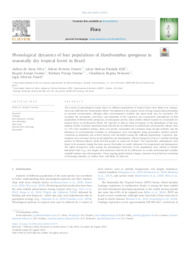Phenological dynamics of four populations of Handroanthus spongiosus in seasonally dry tropical forest in Brazil.
Phenological dynamics of four populations of Handroanthus spongiosus in seasonally dry tropical forest in Brazil.
Author(s): SILVA, J. de J.; DUARTE, E. F.; KIILL, L. H. P.; GOMES, R. A.; DANTAS, B. F.; PELACANI, C. R.; FUNCH, L. S.
Summary: The scarcity of phenological studies based on different populations of tropical forest trees limits seed management and collection for reforestation efforts. Precipitation is the primary factor driving tropical plant phenology in seasonal environments, although other environmental variables and plant traits may be associated. We examined the seasonality, synchrony, and intensities of the vegetative and reproductive phenophases of four populations of Handroanthus spongiosus, an endangered species, under similar climate regimes in a seasonally dry tropical forest, in northeastern Brazil. We expected to observe some divergence in the phenologies of the populations related to distinct functional traits selected for by differences in rainfall and soil properties. Mature trees (n = 87) were monitored during a three-year period. Seasonality was examined using circular statistics, and the influences of environmental variables on phenophases were investigated using generalized additive models. Variations in intensities and activity indices were identified among the different populations. Vegetative phenophases were seasonal, driven by precipitation and photoperiod, with leaf longevity of up to 7 months; budding peaked in February-March, while leaf fall peaked in April and October. The reproductive phenophases were found to be seasonal, during the rainy season (November to April), influenced by temperature and photoperiod. The slight divergences noted among the phenological behaviors of the populations were related to distinct functional traits (e.g., tree height, stem diameter) selected for by differences in certain environmental variables (rainfall volumes and soil properties). Given ongoing global climate changes, increases in leaf fall and reductions of flowering intensity, as verified here, will likely be observed.
Publication year: 2023
Types of publication: Journal article
Unit: Embrapa Semi-arid Region
Observation
Some of Embrapa's publications are published as ePub files. To read them, use or download one of the following free software options to your computer or mobile device. Android: Google Play Books; IOS: iBooks; Windows and Linux: Calibre.
Access other publications
Access the Agricultural Research Database (BDPA) to consult Embrapa's full library collection and records.
Visit Embrapa Bookstore to purchase books and other publications sold by Embrapa.

